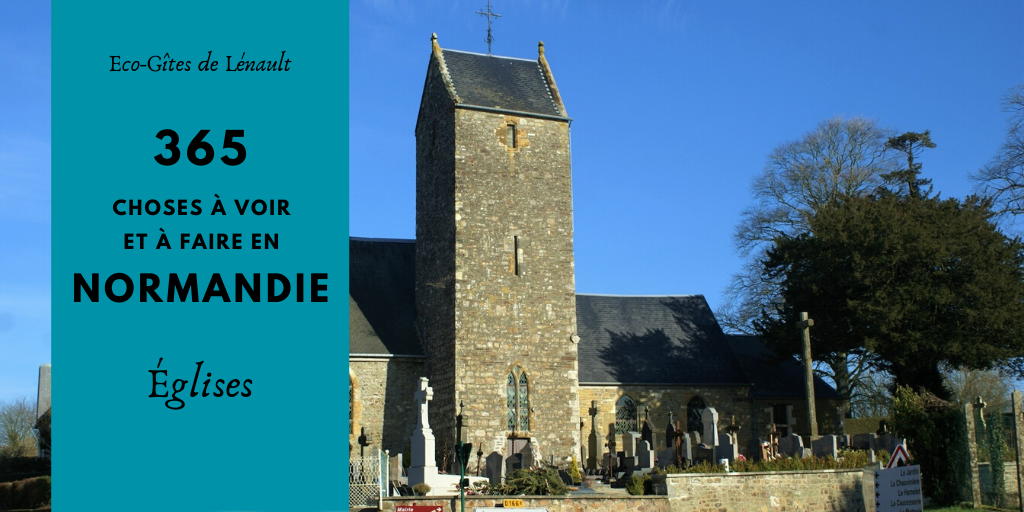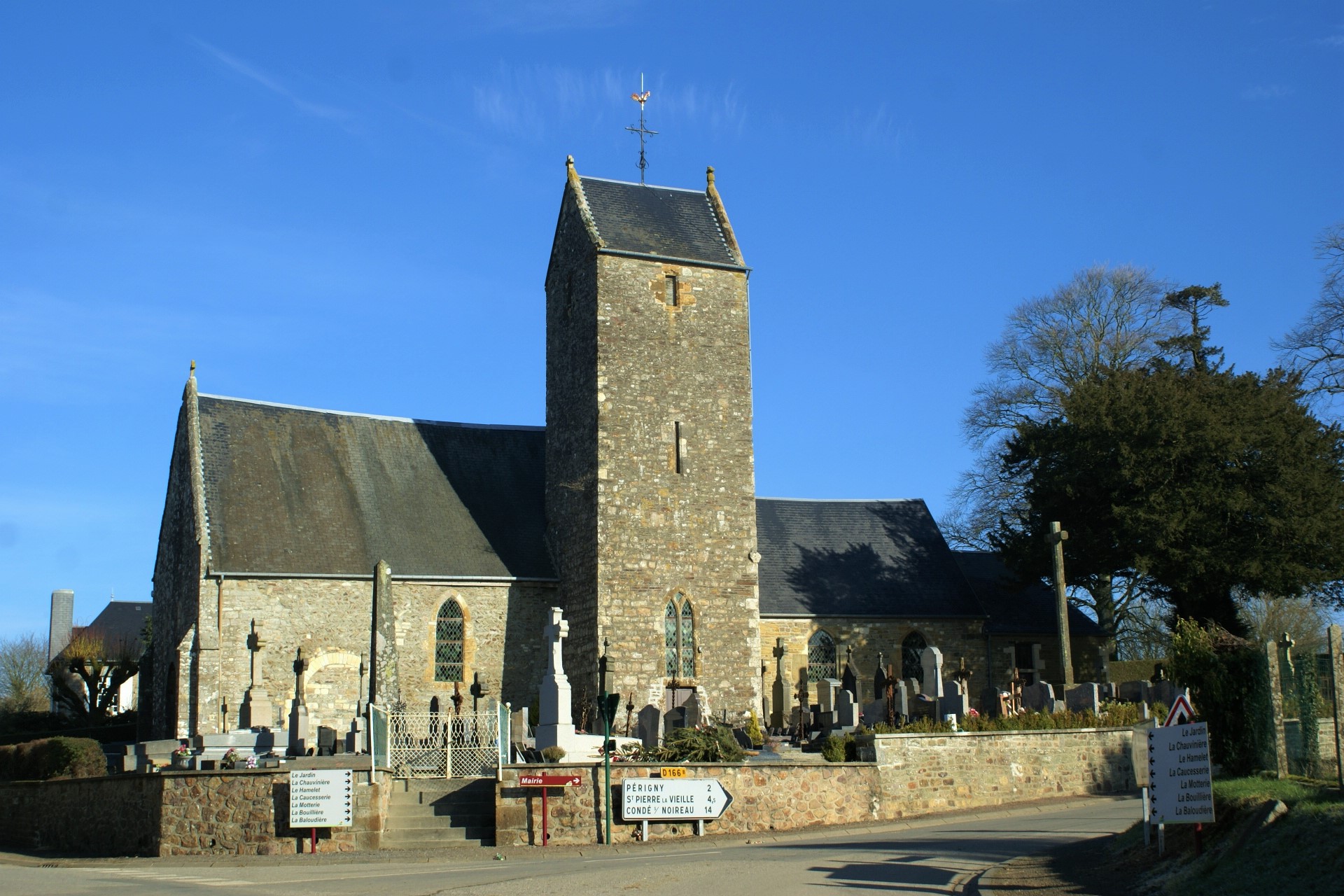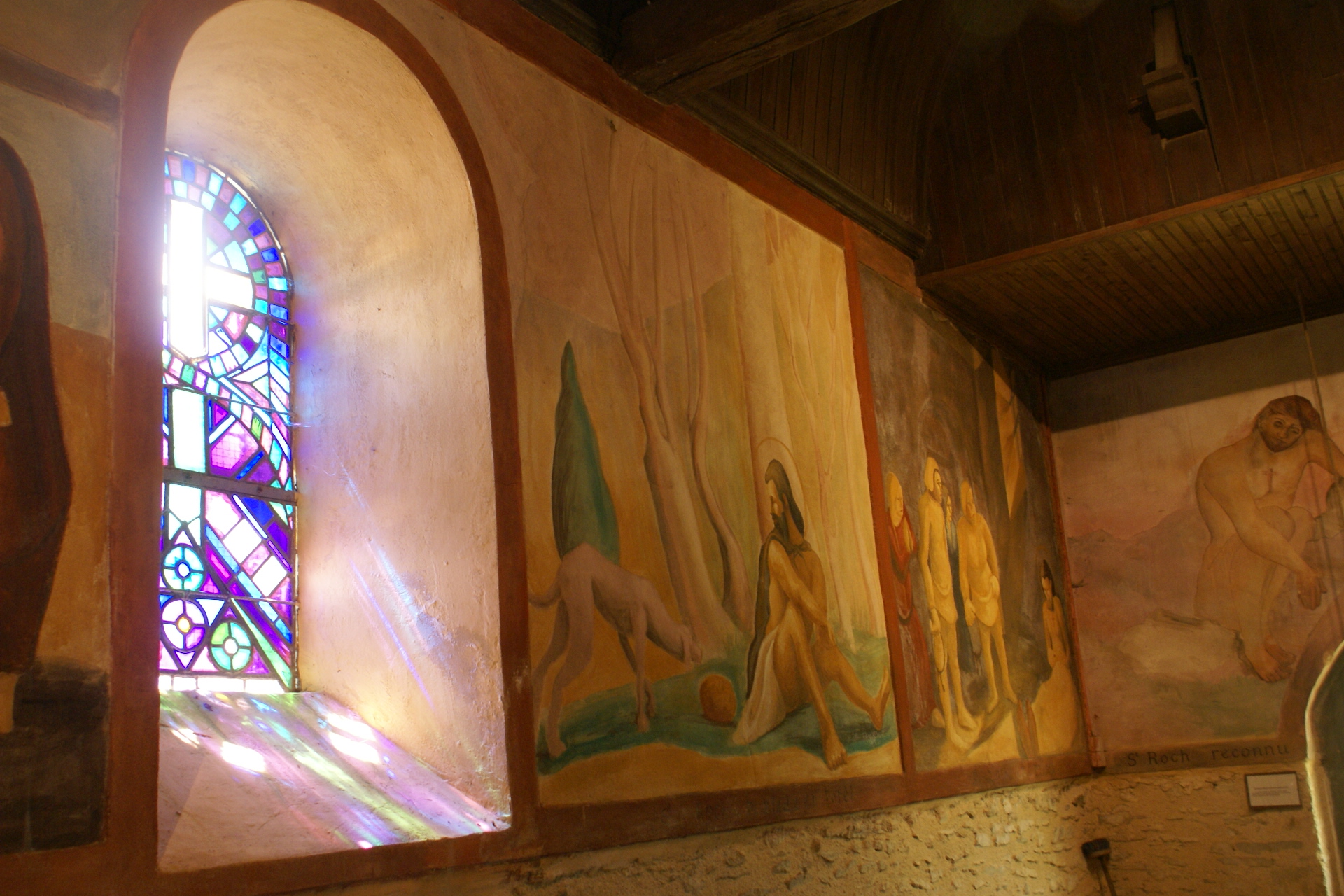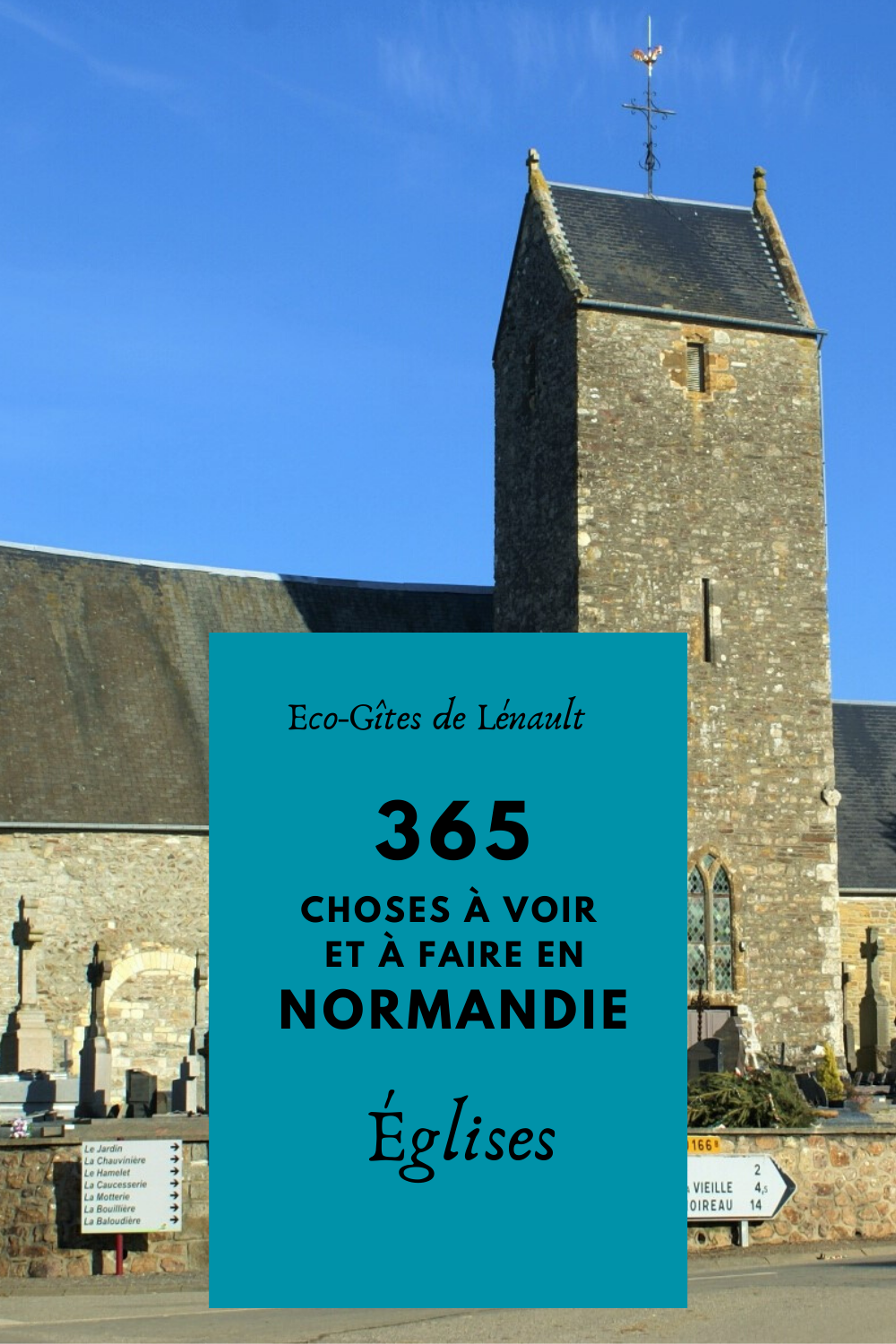365: Normandy Churches - Les Églises de Normandie

Week 7 of my 365 things to see and do in Normandy is all about churches. Some date way back to the 10th century, others are modern. You'll even find a reconstruction of a famous site of pilgrimage.
La semaine 7 de mes 365 choses à voir et à faire en Normandie concerne les églises. Certains remontent au 10e siècle, d'autres sont modernes. Vous trouverez même une reconstitution d'un célèbre site de pèlerinage.

Churches of Normandy - Les Églises de Normandie
1. Lénault - Église de l'Assomption Notre-Dame
The church in Lénault was originally built in the 15th century although the oldest remaining parts now date from the 16th century when it was built by the English at the time when Normandy and England were the same country. Hence at first glance it appears very English in style but once inside it is quite different and reflects the fact it is a Catholic church. It is now no longer used for services and only for burials in the churchyard. The churchyard is also very different from an English one with the graves generally marked with large crosses and a marble tomb covering.
L’Eglise de l'Assomption Notre Dame de Lénault a été construite du XVe au XIXe siècle. La partie la plus ancienne date du XVIe siècle avec son clocher à bâtière a été construite au XVIe siècle par les Anglais. L'église n'est maintenant utilisée que pour les inhumations mais reste ouverte aux visiteurs pour l'explorer à l'intérieur.

2. Aunay-sur-Odon - L'église Saint-Samson
Totally different to the ancient village church in Lénault, l'église Saint-Samson in Aunay-sur-Odon is modern. Due to its strategic location the town was bombed heavily after D-Day and by June 15th 1944 the only thing left standing was the bell tower of the church. It was however too damaged to be saved and the whole the church was rebuilt in 1951, the first church in Calvados to be rebuilt after World War 2.
L'église Saint-Samson à Aunay sur Odon est de conception moderne ayant été presque totalement détruite pendant la Seconde Guerre mondial. C'est à sa position de carrefour, entre Caen et Vire et entre Bayeux et Falaise, qu'entre 12 et 15 juin 1944, la ville est totalement anéantie. Le clocher était le seul édifice restant. Il était cependant trop dangereux pour être sauvé et l'église entière a été reconstruite en 1951, la première église à être reconstruite après la Seconde Guerre mondiale dans le Calvados.
3. Sainte Mère-Église
Another church with a World War 2 connection. This time the church is famous because it became the unexpected landing spot for paratrooper John Steele of the 505th Parachute Infantry Regiment. Whilst parachuting into the area in the early hours of June 6th 1944, John Steele's parachute caught on the spire of the town church. He remained there for 2 hours, pretending to be dead before finally being prisoner by the Germans. However he escaped 3 days later. Today a dummy American paratrooper hangs from the spire in his memory.
Une autre église avec une connexion à la Seconde Guerre Mondiale. Cette fois, l'église est célèbre parce que un parachutiste du 505th Parachute Infantry Regiment s'est attaché à son clocher. Pendant le parachutage dans la région aux premières heures du 6 juin 1944, le parachute de John Steele s'est accroché au clocher de l'église. Il y est resté 2 heures, faisant semblant d'être mort, avant d'être finalement fait prisonnier par les Allemands. Il s'est échappé trois jours plus tard. Aujourd'hui, un parachutiste américain factice est suspendu au clocher en sa mémoire.
4. Chapelle Saint-Roch, St Mars d'Ouilly near Pont D'ouilly
You might easily pass by this small roadside chapel a few kms outside of Pont D'Ouilly but if you do you will be missing a hidden gem. In years gone by the church was a place of pilgrimage but it fell into disrepair. During restoration works in the 1930's 8 large frescoes were painted on the walls depicting life life of Saint-Roch and 2 further frescoes were added in the 80's. Every year on the Sunday following Aug 15th a modern day pilgrimage takes place across the fields and mass is celebrated at the chapel: the Grand Pardon de Saint-Roch.
Vous pourriez facilement passer par cette petite chapelle en bordure de route à quelques kilomètres à l'extérieur de Pont D'Ouilly mais si vous le faites, vous émettrez un joyau caché. Autrefois, l'église était un lieu de pèlerinage mais elle est tombée en ruine. Lors de travaux de restauration dans les années 1930, 8 fresques ont été peintes sur les murs illustrant la vie de Saint-Roch et 2 autres fresques ont été ajoutées dans les années 80. Chaque année, le dimanche suivant le 15 août, un pèlerinage moderne a lieu à travers les champs et la messe est célébrée à la chapelle: le Grand Pardon de Saint-Roch.

5. Le Petit Lourdes
Le Petit Lourdes is a two thirds replica of the real Lourdes built at d’Hérouville-Saint-Clair. It was built by Monsieur Dunoscq in 1878 after his wife was healed after visiting Lourdes in the Hautes-Pyrénées and he wanted to offer people in Normandy the chance for pilgrimage even if they were unable to travel far.
Le Petit Lourdes est un sanctuaire marial construit à d’Hérouville-Saint-Clair. C’est une réplique exacte aux deux tiers de Lourdes, formulé par Monsieur Dunoscq en 1878 après la guérison miraculeuse de son épouse dans la cité mariale de Lourdes dans les Hautes-Pyrénées. Son idée, permettre à tous les Normands d’aller en pèlerinage et aussi un moyen de permettre à ceux qui ne peuvent pas s’offrir le voyage jusque dans les Pyrénées de ce recueillir.
6. The Priory Saint-Arnoult: the oldest Christian building in Calvados
The religious site at Saint-Arnoult has at various times been a church, a chapel and a priory and is currently being sympathetically restored. Restoration works carried out in 2010 has led to the discovery that this is the oldest know church building in Calvados, dating back to the 10th century. You can read more about its story here.
Le ancien prieuré est complexe car il comprend à la fois une chapelle priorale et une église paroissiale ruinée. Les études récentes réalisées au début des années 2010 ont permis de découvrir qu'il s'agit du plus ancien édifice connu du Calvados, datant du Xe siècle. Vous pouvez en savoir plus sur son histoire ici:
7. Church of Saint-Pierre, Caen
Its size often leads people to mistakenly assume that Saint-Pierre is a cathedral with the magnificent 260ft 14th century spire and ornate stonework easily adding to the confusion. As with much of Caen, it was badly damaged in World War 2 and is still undergoing restoration work. Work was first started in the current building in the 13th century and it exhibits a wide range of architectural styles that have been added through the ages. Its most modern addition is the suspended organ built in 1997.
Cette magnifique église avec sa tour de 80m construite à l'origine au 14ème siècle en fait un bâtiment imposant au centre de Caen. Comme beaucoup de Caen, il a été bombardé pendant la Seconde Guerre mondiale et continue de subir des travaux de restauration. L'église présente plusieurs styles architecturaux, l'ajout le plus moderne étant un orgue suspendu construit en 1997.

*********************
Obviously Normandy has many more interesting churches than I can write about here. As you drive round the region you will see them in every village and town and you may note that their towers generally take one of 3 forms: either a square tower with 2 sided roof as seen in Lenault, a spire that rises to a single point, most often with 8 sides but sometimes only 4 or a dome that is sometimes also topped with a small spire. Common to almost all, though, is the fact there is a cockerel on each spire or tower. No-one is altogether sure why this is the case but it is not because Le Coq is the symbol of France. Do you have any suggestions why they are there?
Did you also know that in a town in Calvados you can find France's largest wooden church? It has an 8 sided spire topped with a cross and a cockerel. But do you know where it is? I'll drop the answer in a comment.
Il est évident que la Normandie a beaucoup plus d'églises intéressantes que je ne peux en écrire ici. En parcourant la région, vous remarquerez peut-être que leurs tours prennent généralement l'une des trois formes: soit une tour carrée avec un toit à 2 côtés comme on le voit à Lenault, soit une flèche qui s'élève en un seul point, le plus souvent avec 8 côtés mais parfois seulement 4 ou un dôme qui est parfois également surmonté d'une petite flèche. Le point commun à presque tous est qu'il y a un coq sur chaque flèche ou tour. Personne ne sait vraiment pourquoi c'est le cas, mais ce n'est pas parce que Le Coq est le symbole de la France. Avez-vous des suggestions pourquoi ils sont là?
Saviez-vous également que dans une ville du Calvados se trouve la plus grande église en bois de France? Il a une flèche à 8 côtés surmontée d'une croix et d'un coq. Mais savez-vous où c'est? Je vais mettre la réponse dans un commentaire.
You can pin these for later!
 |
 |

